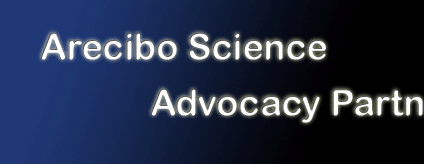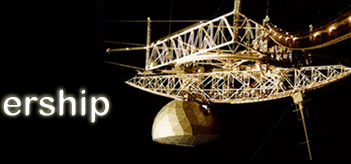

Arecibo Science Advocacy Partnership
AO Management Re-Competition Statement of Principles 31st March 2009 The ASAP Board represents a broad cross-section of scientists with extensive experience and knowledge of the scientific capabilities, accomplishments and potential of the Arecibo Observatory (AO). From this perspective, the Board recommends that entities proposing to manage the Observatory recognize and promote the following mission and principles, and endeavor to operate the AO accordingly: Mission Statement: "To optimize and enhance the unique scientific capabilities, productivity and educational impact of the Arecibo Observatory in each of its three principal areas of effort, radio astronomy, space & atmospheric sciences, and radar astronomy"
First: The Arecibo Observatory is a National Science Foundation (NSF) facility well known nationally and internationally for its uniquely sensitive instrument and thus exceptional capabilities for radio/radar astronomy and space/atmospheric studies. Following the Gregorian upgrading and the ALFA multi-beam feed installation, the Arecibo telescope is essentially a new instrument and places high on any short list of the world's great radio telescopes. A broad range of leading, highly competitive and cost-effective scientific programs have been founded on the AO's unique capabilities and depend critically on them. The scientific programs of the Arecibo Observatory have long been operated under the NSF open skies policy. As long as federal funds are the primary source of its operational budget, its national status and open skies policy should be continued by any managing entity. Second: The staff of the Arecibo Observatory makes its scientific and educational work possible. Staff cuts and attrition over the last three years have devastated the AO staff, resulting in a staffing level which is now dangerously thin and patently unsustainable. Moreover, the anticipated management recompetition exacerbates and extends this situation, making staff retention and recruitment even more difficult over the next 18 or so months. The present Arecibo staff possesses a wealth of expertise and understanding of the operations of the Observatory, and retaining these highly skilled and loyal employees will ensure a smooth transition into a new cooperative agreement. Management proposals should strive to maintain current staffing expertise, and seek to rebuild the staff to a sustainable level of service in all three areas. Furthermore, measures should be taken to address essential staffing continuity across future 5-year management agreements. As a national facility, AO's scientific role is appropriately a national one. AO should thus continue to recruit its staff and postdocs through national and international competition.
Third: Similarly, as a national facility, AO's educational mission remains a national one. AO has traditionally involved both graduate and undergraduate students as well as postdocs in research, though a variety of means—fellowships, the REU programs and relationships with researchers at primarily undergraduate institutions (PUIs), universities and other institutes—and many such people have gone on to occupy prominent positions in the scientific infrastructure of the US. Cultivating graduate and undergraduate students as future researchers in radio astronomy, aeronomy, and planetary radar is an important aspect of the Observatory's operation that should continue. Management proposals should draw on the expertise of established users situated in both PUIs and universities, both in Puerto Rico and on the mainland, since PUIs are very important in educating and mentoring large numbers of future scientists.
Fourth: Arecibo Observatory is also a major and prominent research facility in Latin America. It is much prized in Puerto Rico, and its Visitor Center is a major educational facility in this region, being visited by hundreds of thousands of local residents and tourists each year. This unique and prominent position should also be recognized, maintained and cultivated. Any managing entity should therefore cultivate strong relationships with Puerto Rican institutions including the Commonwealth government. It is even possible that some ancillary funding may be available from local sources; however, as a national NSF facility, the primary funding responsibility remains a national one.
Fifth: Given current funding uncertainties, local staff has been active in seeking local partnerships with Puerto Rican institutions. Such activities seek to maximize AO's educational impact in a region of the country underrepresented in science. These imply cooperation with local colleges and universities and greater interaction with their students. Future manager of the AO should encourage such arrangements.
Sixth: The organization managing the AO must put adequate resources into long term planning for the technical, scientific and educational excellence of the AO. As such opportunities change continuously, such planning requires serious and sustained attention. Positive examples of such planning are the ALFA feed array and the new ionospheric heating facility. Any managing organization therefore needs to be sensitive to such demands on the Observatory, and on the ways in which they can be addressed by creative planning, external partnerships and consortia so as to sustain and enhance AO's scientific productivity throughout its useful life.
--------------------------------
The ASAP Board stands ready to assist and advise all organizations proposing to manage the Arecibo Observatory so as to enhance the scientific productivity and stature of this great instrument.